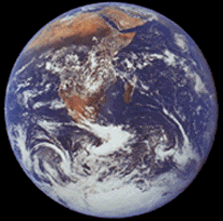This photo was taken in December 1972 by the Apollo 17 crew. The spacecraft was traveling between the Earth and the Moon. The reddish landmass is Africa and Saudi Arabia which is desert. The white is both clouds and the ice covering Antarctica.
Click on image for full size
Image courtesy of NASA/JPL
Earth--What a Drag!?!
News story originally written on April 1, 1998
The first direct evidence has just been found that shows the Earth does drag quite a bit - it drags space and time around itself as it rotates! This drag effect was predicted 80 years ago using
Einstein's theory of general relativity.
Researchers have been measuring the shifting of two satellites - LAGEOS I and LAGEOS II. LAGEOS stands for Laser Geodynamics Satellite. One of the researchers, Dr. Erricos Pavlis of the Joint Center for Earth System Technology remarked, "We found that the plane of the orbits of LAGEOS I and II were shifted about six feet (two meters) per year in the direction
of the Earth's rotation." This shift is the first direct measurement of the effect called 'frame dragging'.
"General relativity predicts that massive rotating objects should drag space-time around themselves as they rotate," said Pavlis. "Frame dragging is like what happens if a bowling ball spins in a thick fluid such as molasses. As the ball spins, it pulls the molasses around itself. Anything stuck in the molasses will also move around the ball. Similarly, as the Earth rotates, it pulls space-time in its vicinity around itself. This will shift the orbits of satellites near the Earth."
Dr. John Ries, an expert in satellite geodesy at the University of Texas at Austin, cautions that there is a lot of uncertainty involved in the research being done. Certainly, there is more work to be done in this area. The next step will be taken by the LAGEOS III mission.
You might also be interested in:

It was another exciting and frustrating year for the space science program. It seemed that every step forward led to one backwards. Either way, NASA led the way to a great century of discovery. Unfortunately,
...more
The Space Shuttle Discovery lifted off from Kennedy Space Center at 2:19 p.m. EST, October 29th. The sky was clear and the weather was great as Discovery took 8 1/2 minutes to reach orbit for the Unitied
...more
A moon was discovered orbiting the asteroid, Eugenia. This is only the second time in history that a satellite has been seen circling an asteroid. A special mirror allowed scientists to find the moon
...more
Will Russia ever put the service module for the International Space Station in space? NASA officials are demanding an answer from the Russian government. The necessary service module is currently waiting
...more
During a period of about two days in early May, 1998, the ACE spacecraft was immersed in plasma associated with a coronal mass ejection (CME). The SWICS instrument on ACE, which determines unambiguously
...more
J.S. Maini of the Canadian Forest Service has referred to forests as the "heart and lungs of the world." Forests reduce soil erosion, maintain water quality, contribute to atmospheric humidity and cloud
...more
In late April through mid-May 2002, all five naked-eye planets are visible simultaneously in the night sky! This is includes Mercury which is generally very hard to see because of its proximity to the
...more















